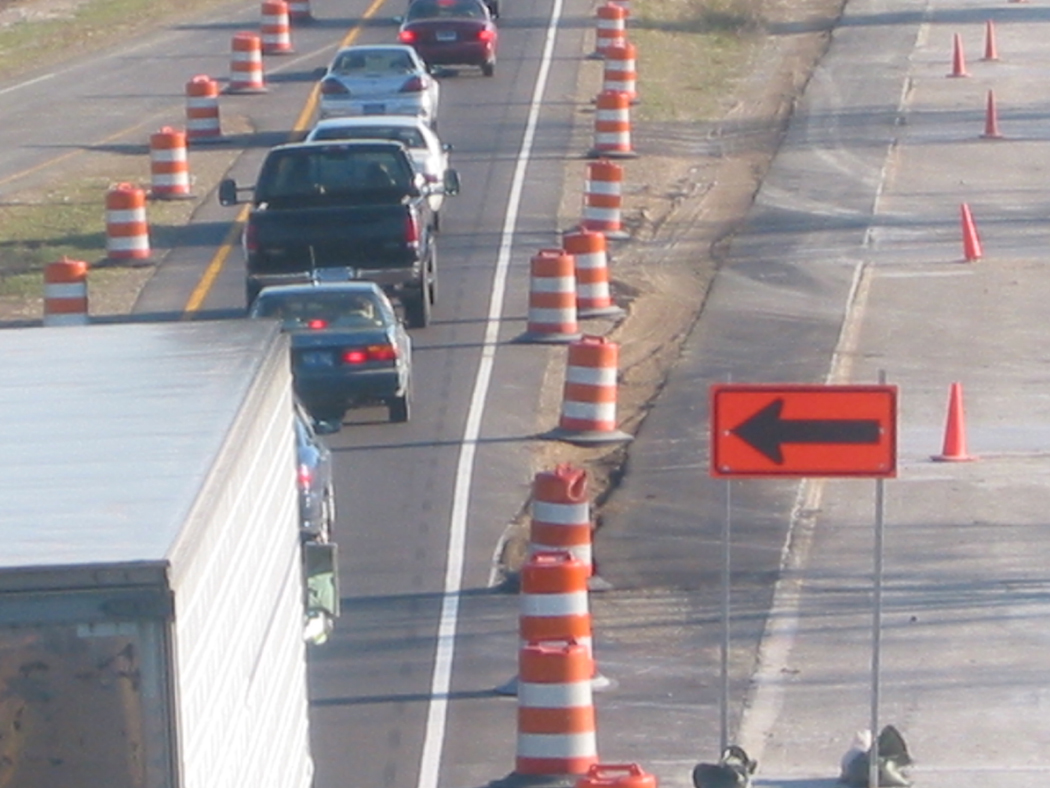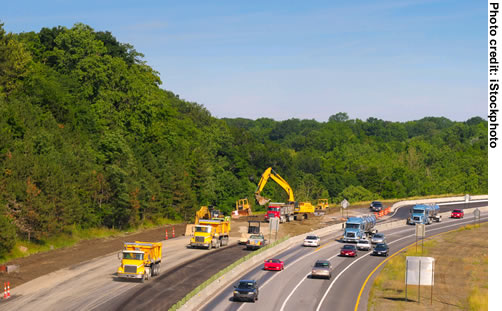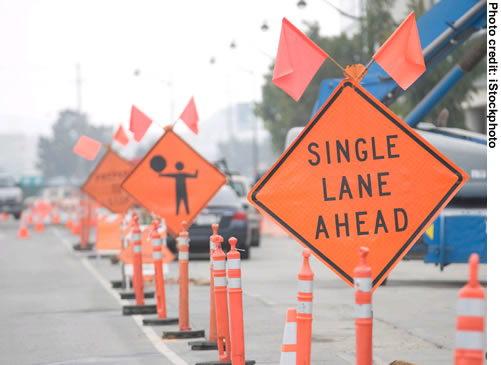U.S. Department of Transportation
Federal Highway Administration
1200 New Jersey Avenue, SE
Washington, DC 20590
202-366-4000
Focus
| Accelerating Infrastructure Innovations |
Publication Number: FHWA-HRT-09-015
Date: July 2009
 |
| FHWA's new guides will help agencies in using analytical tools for work zone planning and management. |
 |
Two new volumes in the Federal Highway Administration's (FHWA) Traffic Analysis Toolbox series offer transportation departments guidance in using a range of analytical tools for work zone planning and management. "Successfully deployed, these tools can be invaluable assets in understanding and minimizing road user delays and keeping key stakeholders informed," says Tracy Scriba of FHWA. "While the use of analytical tools as part of work zone impacts analysis may not be necessary for every project, these guides will help agencies understand the available analytical approaches and tools and determine how and when they might be best applied to support work zone analysis and decisionmaking."
The analytical tools can include software such as FHWA's QuickZone program and CA4PRS (Construction Analysis for Pavement Rehabilitation Strategies), which was developed under an FHWA pooled fund study by the Institute of Transportation Studies at the University of California at Berkeley (see October 2008 Focus).
Analyzing work zone impacts can help transportation agency personnel improve decisionmaking, taking into consideration the many factors affecting work zone planning such as mobility needs, finances, environmental impacts, safety, and user costs. "Having a better understanding of likely work zone impacts can help State and local agency staff make more informed decisions during planning, design, and construction and know how those decisions are likely to affect road users, businesses, other transportation modes, and transportation system performance," says Scriba.
Work zone analysis can include consideration of impacts to:
Volume VIII in the Toolbox series, Work Zone Modeling and Simulation-A Guide for Decision-Makers (Pub. No. FHWA-HOP-08-029), offers high-level guidance to executive staff on how analytical tools can be used to support work zone decisionmaking throughout an entire project life cycle. The guide categorizes decisionmaking into three types: scheduling, application of construction techniques, and transportation management plan decisions. The guide also identifies six areas of impact that should be considered when analyzing work zones: safety impacts for motorists, safety impacts for workers, mobility impacts, economic considerations, environmental concerns, and user costs. Primary attention is given to mobility impacts, where the broadest range of tools and analytical techniques are available. A section on transportation analysis approaches describes the classes of tools available to support work zone mobility analysis, including sketch-planning tools, travel demand models, and simulation models.
"The guide also features a sample analysis process and checklist that may prove helpful in structuring an effective approach to using an analytical process to support work zone planning," says Scriba.
Volume IX of the Toolbox, Work Zone Modeling and Simulation-A Guide for Analysts (Pub. No. FHWA-HOP-09-001), provides specific guidance to an analyst, researcher, or manager in charge of conducting a work zone analysis project or developing an overall work zone modeling program or approach. The volume includes numerous case study examples, including a pavement reconstruction project on I-15 in California, the rehabilitation of the Going to the Sun Road in Montana's Glacier National Park, and the reconstruction of the Woodrow Wilson Bridge outside of Washington, DC.
Featured in Volume IX is detailed discussion of five categories of work zone analysis factors that should be considered when deciding whether or not to conduct a work zone analysis: work zone characteristics; transportation management plan strategies, including temporary traffic control and public information strategies; data, including the availability and quality of the data; agency resources; and work zone performance measures, including travel time, delay, queue length, speed, and financial impacts. Additional topics include establishing a strategic methodology for work zone analysis and identifying a transportation modeling approach.
Volumes VIII and IX of the Traffic Analysis Toolbox are available online at www.ops.fhwa.dot.gov/wz/traffic_analysis. Printed copies are available at no cost by sending an email with the name of the requested publication and shipping information to workzonepubs@dot.gov. The two new Toolbox volumes build on an earlier FHWA guide that discussed the range of work zone impacts issues and a broad framework for assessing those impacts. This earlier guide, Work Zone Impacts Assessment: An Approach to Assess and Manage Work Zone Safety and Mobility Impacts of Road Projects (Pub. No. FHWA-HOP-05-068), is also available online at www.ops.fhwa.dot.gov/wz/resources/final_rule/wzi_guide/index.htm and in print by emailing workzonepubs@dot.gov. Additional online resources include FHWA's Web pages on Types of Traffic Analysis Tools (www.ops.fhwa.dot.gov/trafficanalysistools/type_tools.htm), Work Zone Traffic Analysis (www.ops.fhwa.dot.gov/wz/traffic_analysis), and Work Zone Traffic Management (www.ops.fhwa.dot.gov/wz/traffic_mgmt). For more information, contact Tracy Scriba at FHWA, 202-366-0855 (email: tracy.scriba@fhwa.dot.gov), or Chung Eng at FHWA, 202-366-8043 (email: chung.eng@fhwa.dot.gov).
For information on workshops that FHWA will be holding on the new Traffic Analysis Toolbox guides, contact Daniel Grate at the FHWA Resource Center, 404-562-3912 (email: daniel.grate@fhwa.dot.gov).
A quick overview of work zone analysis is offered in a new FHWA brochure, Using Modeling and Simulation Tools for Work Zone Analysis (Pub No. FHWA-HOP-09-038). The brochure looks at the definition of work zone analysis, as well as how modeling and simulation can be used as part of the analysis. Several case studies are also highlighted. To download the brochure, visit www.ops.fhwa.dot.gov/wz/traffic_analysis (see "Work Zone Analysis Leaflet").
 |
| Analytical tools can provide agencies with a better understanding of roadway work zone impacts. |